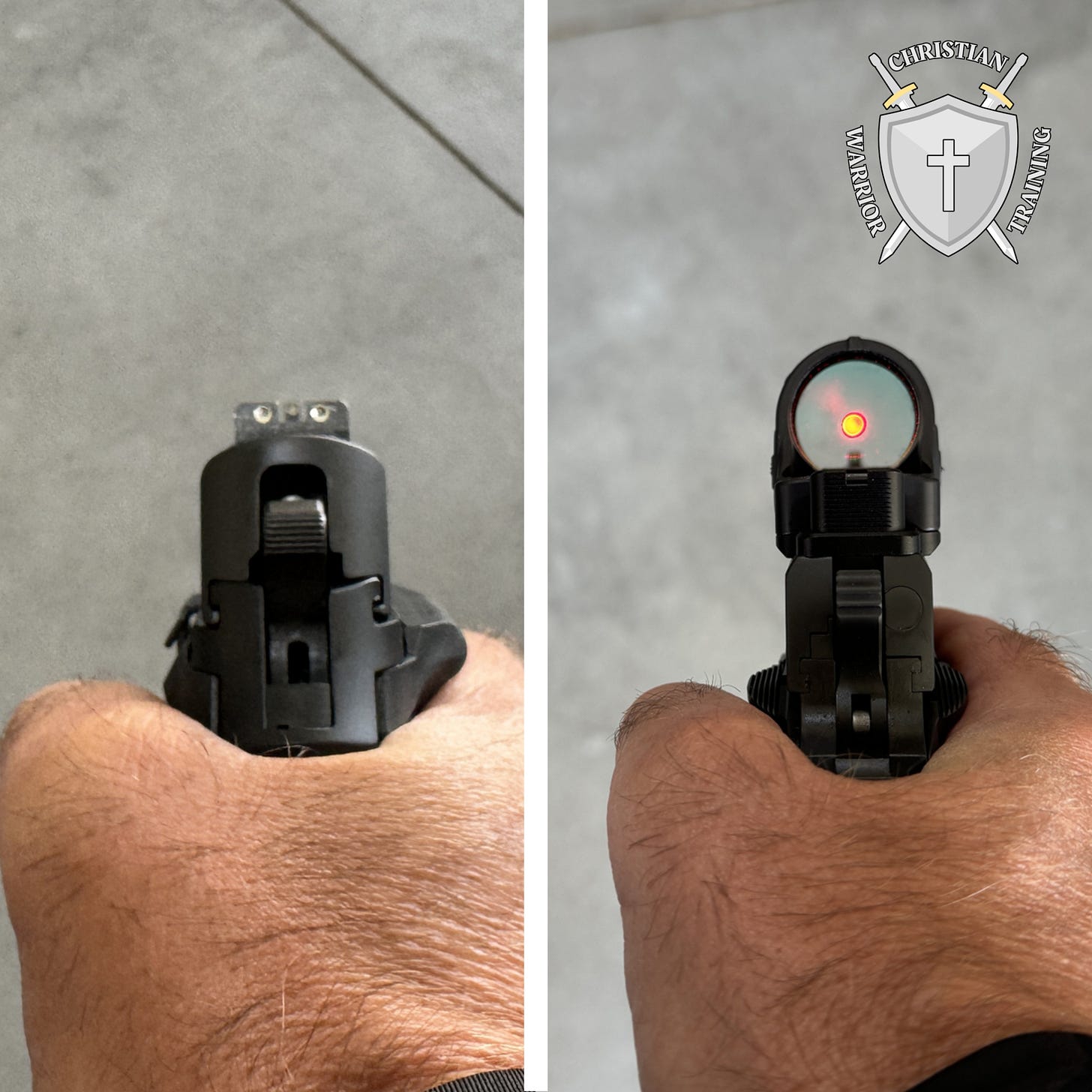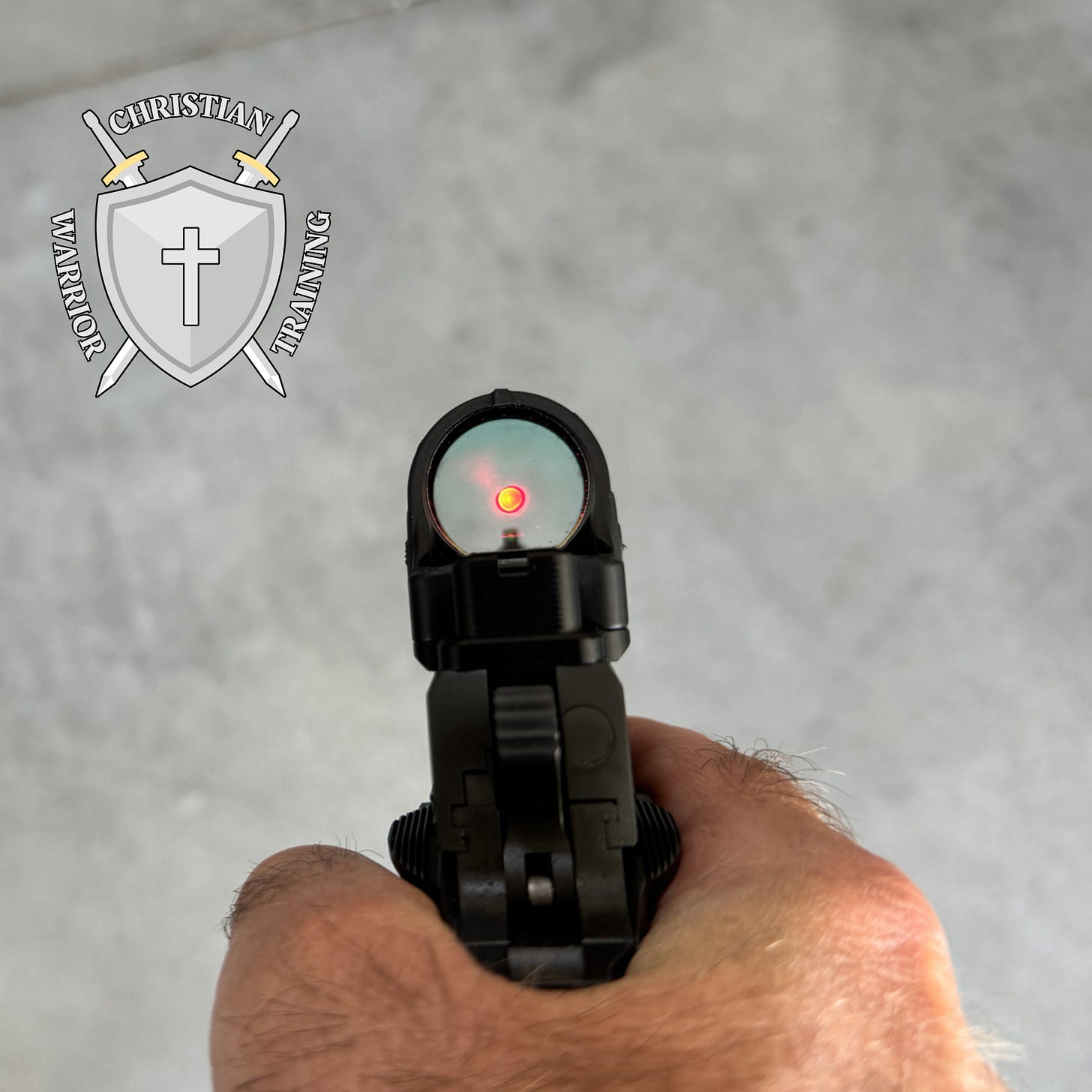3 Reasons to Transition to Red Dot Sights on Your Handguns
Transition from iron sights to red dot sights to improve your shooting.
Red Dot Sights for Your Pistol
As church safety ministries continue to prioritize the protection and security of their congregations, transitioning to red dot sight (RDS) handguns has emerged as a significant advancement in firearm technology. The evolution from traditional iron sights to RDS is driven by the need for greater accuracy, enhanced threat assessment, and improved performance in various operational environments. This article will dive into the advantages of RDS for church safety teams, focusing on how these systems enhance situational awareness, improve accuracy, and offer flexibility in diverse lighting conditions. Additionally, I'll explore practical considerations for adopting RDS, including setup preferences and maintenance tips.
Advantage One: Single Focal Plane and Enhanced Threat Focus
One of the most profound benefits of RDS over iron sights is the single focal plane. Traditional iron sights require the shooter to align the rear sight, front sight, and target, with a hard focus on the front sight. This multi-focal process can obscure the target, especially under stress or in dynamic situations. In contrast, RDS allows team members to maintain a clear and continuous focus on the threat while superimposing the red dot over the target.
This shift to a single focal plane simplifies the aiming process, enabling quicker and more intuitive target acquisition. Historical context shows that for millennia, humans have relied on direct focus techniques in hunting and combat, using tools like spears and arrows. Firearms introduced the concept of multi-focal alignment, which, while revolutionary, also introduced complexity. RDS technology reverts to a more natural, direct focus method, aligning with our instinctive visual processing.
In high-stress scenarios, the ability to keep the threat in clear view while aiming enhances a church safety team member's ability to process evolving information, leading to better decision-making and reaction times. This continuous threat assessment is crucial for team members who must remain vigilant and responsive to sudden changes.
Advantage Two: Accuracy Improvement
Accuracy is a critical factor in protecting a congregation. RDS technology significantly improves accuracy by simplifying the aiming process. Team members transitioning from iron sights to RDS often report an initial perception of slower performance. However, this is usually due to a higher standard of precision they unconsciously hold themselves to with RDS.
RDS systems facilitate more precise shot placement by providing a clear, unobstructed view of the target. This advantage is particularly noticeable when tracking moving threats, as the single focal plane allows for smoother, more accurate target tracking. During qualification exercises, team members typically demonstrate improved scores with RDS-equipped handguns, highlighting the technology's impact on shooting proficiency.

Training safety team members on RDS usage is generally quicker and more efficient than with iron sights. The straightforward aiming process reduces the training time required to achieve competency. This efficiency in training not only enhances overall skill levels but also ensures that team members are better prepared for real-world scenarios.
Advantage Three: Adaptability to Various Lighting Conditions and Single-Hand Operation
Church environments often involve varying lighting conditions, from bright daylight during outdoor activities to low-light or no-light settings during evening services or events. Modern RDS units offer manual adjustments for brightness, allowing team members to tailor the sight's visibility to different lighting conditions. This adaptability ensures a clear sight picture, reducing visual confusion and enhancing performance in diverse settings.
Setting up the RDS for optimal performance in varying light conditions can be seamlessly integrated into pre-service equipment checks. A practical method is to project a weapon or handheld light onto a white or light-colored surface and adjust the dot's brightness until it is clearly visible. This step ensures that the sight is ready for immediate use in any lighting scenario.
Another significant advantage of RDS is the ease of single-hand weapon manipulation. In critical incidents where team members might sustain injuries to their hands or arms, the ability to operate the handgun with one hand becomes vital. The larger size and robust design of RDS units facilitate easier slide manipulation using various surfaces, such as doorways, windows, or even holsters. This capability enhances a team member's ability to maintain operational effectiveness even when injured.
Practical Considerations for Transitioning to RDS Handguns
Selecting the Right RDS
Choosing the appropriate RDS setup involves considering various factors, including the type of emitter, power source, and durability. There are two primary types of RDS: closed emitter and open emitter. Closed emitter sights, such as the Aimpoint Acro P-2 and Holosun 509T, offer protection against environmental elements like dirt, water, and debris, making them suitable for rugged use. Open emitter sights, like the Trijicon RMR, are also durable but are more susceptible to obstruction from contaminants.
Battery life and power options are critical considerations. Some RDS units are battery-powered with solar backups, providing extended operational time and reliability. Closed emitter optics often feature external battery trays, allowing for quick battery changes without removing the sight from the firearm. This design minimizes downtime and ensures the sight remains zeroed, a significant advantage for safety teams responsible for maintaining multiple duty weapons.
Maintenance and Care
Regular maintenance of RDS units is essential to ensure optimal performance. Treating the lenses with anti-fog and water-repellent solutions like RainX or Cat Crap can prevent fogging and reduce the accumulation of dirt and debris. Regularly cleaning the optic windows and checking the battery levels should be part of routine firearm maintenance.
Training and Skill Development
Transitioning to an RDS handgun requires dedicated training to develop proficiency. Dry firing exercises and consistent draw/presentation practice can significantly reduce the learning curve. Team members should incorporate RDS training into their regular firearm practice sessions to build muscle memory and confidence in using the sight.
Conclusion
The transition to red dot sight handguns offers substantial advantages for church safety teams, including enhanced situational awareness, improved accuracy, and greater adaptability in various lighting conditions. While the initial transition may require an adjustment period, the long-term benefits in terms of performance and safety are significant. As technology continues to evolve, RDS systems will likely become a standard component of church safety arsenals, offering team members the tools they need to protect their congregations more effectively and safely.
Other Resources for Reading
Handgun shooting accuracy in low light conditions: The impact of night sights. (n.d.). Policing: An International Journal of Police Strategies & Management, 24(4).
Lewinski, W. (2015). The real risks during deadly shootouts: Accuracy of the naive shooter. Force Science, 27.
Morral, A. R., Hanser, L. M., Rostker, B. D., Hix, W. M., & Jensen, C. (2008, June 19). Evaluation of the New York City Police Department Firearm Training and Firearm-Discharge Review Process (Illustrated). RAND Corporation.
Stringer, G. (2010). Training to Fail: The Failure of Firearms Training For the Real World. Criminal Justice Institute School of Law Enforcement Supervision.
Sage Dynamics White Paper by Aaron Cowan.
Frequently Asked Questions | FAQ
Q: Why should a church safety ministry consider transitioning to red dot handguns?
A: Transitioning to red dot handguns can enhance target focus, make it more difficult for shooters to fix bad shooting habits, and improve accuracy, especially at close ranges.
Q: What is a red dot sight on a handgun?
A: A red dot sight is an optic that allows shooters to quickly acquire the dot and shoot by presenting the gun with the dot on target, replacing traditional iron sights with a red dot.
Q: What is the learning curve for using a red dot handgun?
A: Transitioning from iron sights to a red dot sight may have a learning curve, but with practice and training, many shooters find the transition beneficial for improving their shooting skills.
Q: How can shooters improve their draw stroke with a red dot handgun?
A: Shooters can practice their draw stroke by focusing on acquiring the red dot quickly and presenting the gun with the dot on target, refining their skills for faster and more accurate shooting.
Q: What are some tips for transitioning to a red dot handgun?
A: Three tips for transitioning to a red dot handgun include practicing acquiring the dot quickly, maintaining target focus while shooting, and working with an experienced firearms instructor to refine your skills.
Q: How does a red dot sight on a pistol make it more difficult to fix bad habits?
A: A red dot sight can make it more difficult for shooters to fix bad habits by providing immediate feedback on their shooting skills, encouraging proper technique and alignment to find the red dot consistently.
Q: Why do red dot sights offer an advantage for church safety ministries?
A: Red dot sights offer an advantage for church safety ministries by improving accuracy, target focus, and shooter performance, especially in high-stress situations where quick and precise shooting is crucial.






Optics require training just like iron sights.. Optics can fail just like any electronic or devices. Learn to do well with your iron sights first. Older eyes red dot may not work well, find a green dot. There is a condition called astigmatism can occur in older eyes. It is best to have have both optics and iron sights, you can also put night sights on you EDC. I encourage everyone to take training classes in optics engagement before diving into it. I find an optic with a back up power system works best and my EDC with optics are back with iron sights. Be safe out there and continue to train......train... and more training.
Good article! Advantage 4: You can focus on the target and see the dot even when you have old eyes. As I've gotten older (age 48), in the last year my eyes just don't see things close to me as well as they used to. If I'm trying to focus on the front sight of iron sights they get a little blurry. However, with a red dot, where I can stay target focused and just overlay the dot, I see just fine. I also like that compared to iron sights, when you're looking through the window of the optic, you can see more below your target, so that gives you more room to see if someone is reaching for their waistband, etc. It's taken me a ton of reps to learn to present correctly with the red dot, (compared to iron sights), but now I can present out and pick up the dot quickly and consistently.